Damage, Loss, and Needs Assessment for Disaster Recovery and Reconstruction after the low pressure system associated with Tropical Storm Ida
Heavy precipitation totaling over 450 mm in a three-day period from November 7 to 9, 2009, with a maximum intensity of 355 mm in a five-hour period, caused landslides occurred and rivers to overflow their banks. This heavy precipitation was nearly five times the average precipitation expected for the month of November.
This assessment estimated that the population affected in a primary and secondary manner totals just over 122,000. Based on the use of the disaster assessment methodology developed by CEPAL since 1972, it has been estimated that, besides suffering the regrettable loss of human lives, the value of damages and losses caused by the November 2009 disaster in El Salvador totals US$314.8 million, which represent the equivalent of 1.44% of the country’s gross domestic product (GDP). Of the entire economic effect, US$210.7 million correspond to the destruction of assets (66.9% of total damages and losses), while the remaining US$104.1 million represent changes in economic flows and include both production losses and higher service costs (33.1% of the total).
